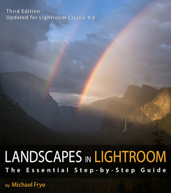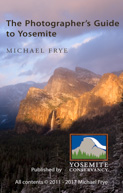In the Moment:
Michael Frye's Landscape Photography Blog
by Michael Frye | Oct 21, 2018 | Light and Weather
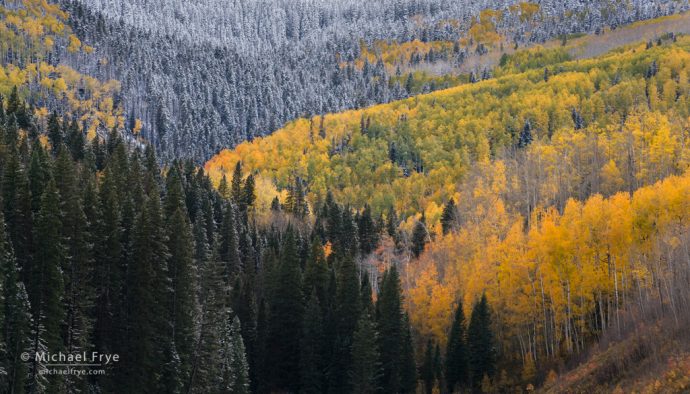
Hillside with aspens and conifers, Uncompahgre NF, CO, USA
We were in Colorado for two-and-a-half weeks, and during that time we watched the upper-elevation aspens lose most of their leaves. The lower-elevation aspens followed, going from green, to yellow and orange, and then, in some cases, bare. Rain and snow set in, and we saw the snow level drop from 11,000 feet down to 10,000 feet, then 9,000 feet, and even briefly down to 8,000 feet. It felt like winter was approaching rapidly.
(more…)
by Michael Frye | Oct 18, 2018 | Light and Weather
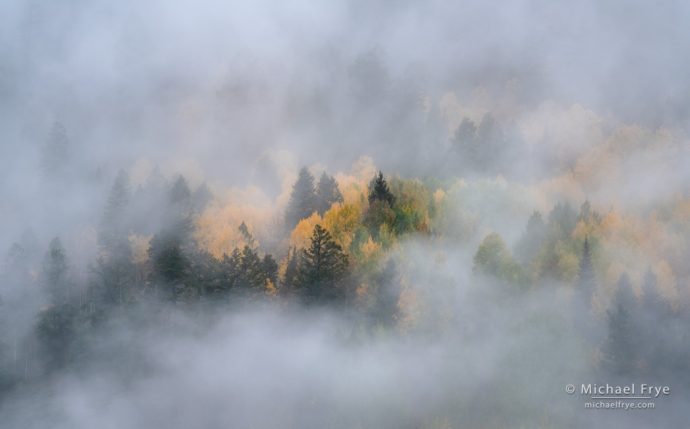
Interesting weather: Autumn hillside in the fog, Uncompahgre NF, CO, USA
As I mentioned in my last post, we got some interesting weather while we were in Colorado – rain, mist, and even some snow. We stayed in the area longer than we originally planned to try to photograph some of this weather, hanging out with our friend Charlotte Gibb during some of that time, and enduring rain in hopes of photographing aspens in the fog or snow.
(more…)
by Michael Frye | Oct 14, 2018 | Composition, Travels and Stories
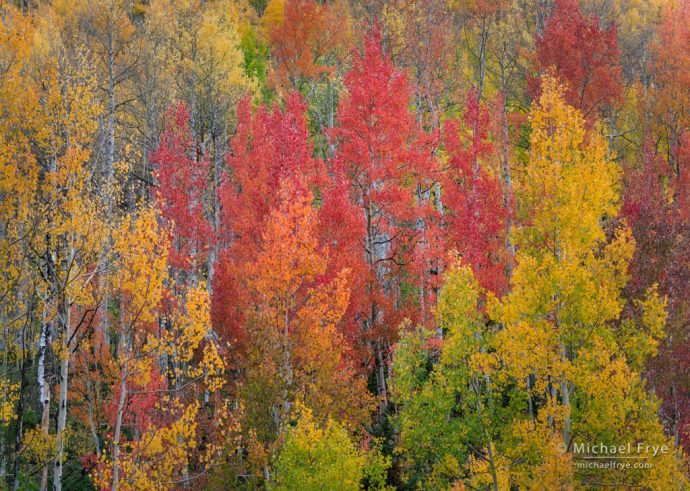
Aspen kaleidoscope, Uncompahgre NF, CO, USA
Claudia and I made our annual pilgrimage to Colorado to see the aspens, with a short detour into some Utah canyons. We’ve actually been traveling for three weeks, and just got home. During our trip we got up before sunrise almost every morning, and stayed out until after sunset nearly every evening. I kept thinking that I should post some photos, but there always seemed to be some interesting weather, and photos to be made, and barely enough time to eat, sleep, and then get up at 5:30 and do it all over again.
(more…)
by Michael Frye | Sep 16, 2018 | Vision and Creativity
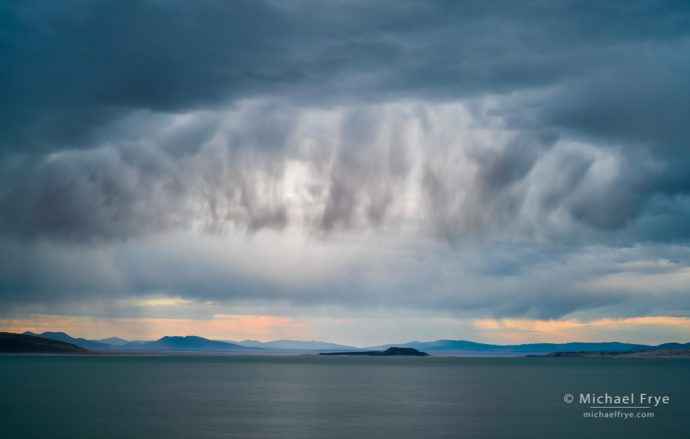
Storm clouds over Mono Lake, CA, USA. 50mm, 20 seconds at f/8, ISO 100, ten-stop ND filter.
Claudia and I spent many days in Lee Vining over the last month-and-a-half. We’ve done three night photography workshops there, and the iPhone workshop Robert Eckhardt taught for us at Bodie.
Before one of our night workshops Charlotte Gibb and I headed to a favorite Mono Lake viewpoint, hoping for a photogenic sunset. When we first arrived we found some dramatic storm clouds and virga over the lake (virga is rain that doesn’t reach the ground). Later the sun broke through, soft of, off in the distance, and we even saw a faint rainbow. I photographed it all, but my favorite images were the early ones of those dramatic clouds. That wasn’t what I was expecting or hoping for, but it’s what I got, and I really liked the mood that sky created.
(more…)
by Michael Frye | Sep 3, 2018 | Travels and Stories, Yosemite Photo Conditions
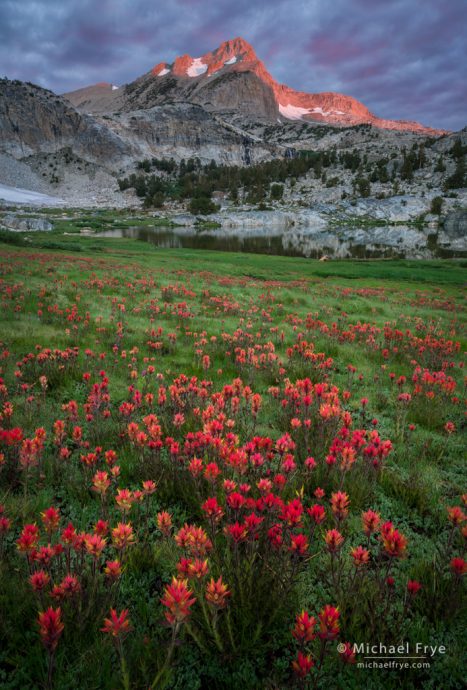
Paintbrush and peak, sunrise, Inyo NF, California. Since the closest flowers were only a foot from the camera, I used focus-stacking to get everything in focus, blending five frames with Helicon Focus. (Exposures were 1.5 seconds at f/16, ISO 100, focal length was 23mm.)
Last winter was a strange one in the Yosemite area, with most of the precipitation coming in March, followed by a big, warm rainstorm in early April that created flooding in Yosemite Valley. That rainstorm melted much of the snowpack below 9,000 feet, so spring came early in those low- and mid-elevation areas. We found some nice flower displays at those elevations, but nothing exceptional.
Above 9,000 feet, however, the snowpack remained intact, even after the early-April flood. And that lingering snow led to an exceptional bloom in the highest elevations. Back in July, before the fires, Claudia and I photographed the flowers as much as we could, and we also led our Range of Light workshop group to a couple of our favorite flower spots.
(more…)
by Michael Frye | Aug 28, 2018 | Smartphone Photography, Travels and Stories, Workshops
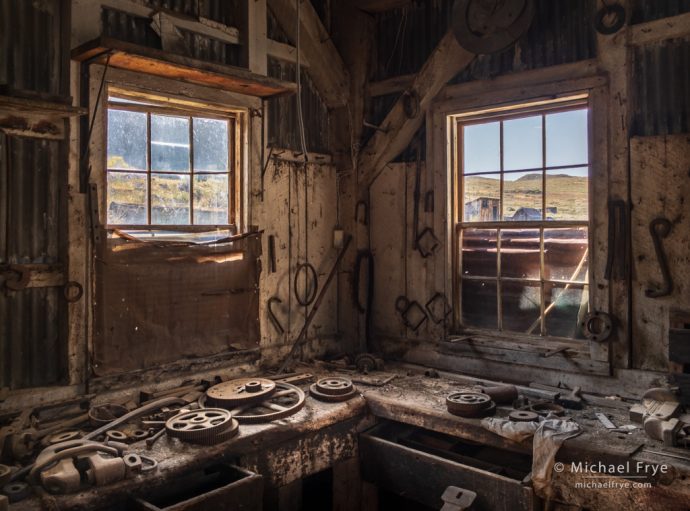
Standard Stamp Mill, Bodie SHP, CA, USA
Two weeks ago our good friend Robert Eckhardt conducted another iPhone photography workshop for us. This time we were based in Lee Vining, and the workshop included two trips to Bodie, with special access to the interiors. It was so much fun.
I hadn’t photographed Bodie interiors in two years. Bodie endured two earthquakes in December of 2016, causing structural damage to some of the buildings, and knocking over bottles, shelves, and other objects. So no photography workshops were allowed into the interiors in 2017 while the park assessed the damage.
(more…)
by Michael Frye | Aug 20, 2018 | Uncategorized
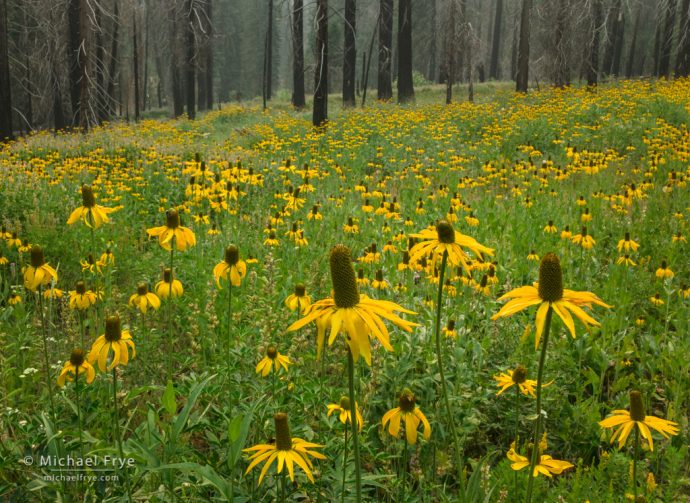
Coneflowers in a forest burned by the Rim Fire, near Crane Flat, Yosemite
The Ferguson Fire, which has been burning on the western edge of Yosemite since July 13th, is now 100% contained. The other major fires in California, like the Mendocino Complex and Carr fires, are still burning, but nearing containment. Skies around the state have become much less smoky over the last week or two.
Tragically, two firefighters died battling the Ferguson Fire, but no homes were lost. We were lucky around here compared to the people in Redding, where the Carr Fire destroyed over 1,000 homes, and eight people lost their lives.
(more…)
by Michael Frye | Aug 12, 2018 | Night Photography
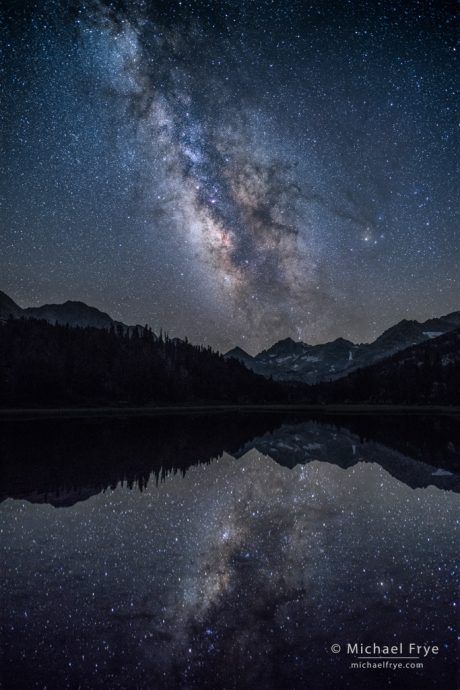
Milky Way, mountains, and reflections, Inyo National Forest. 20 frames blended together with Starry Landscape Stacker to reduce noise. Each frame was 10 seconds at f/2.5, ISO 12,800.
As most of you know, California has endured a rash of wildfires in recent weeks. One of those fires, the Ferguson Fire, has been burning along the western edge of Yosemite for the last month. The park service eventually closed Yosemite Valley due to smoke and the threat of fire cutting off the roads that access the valley.
Our recent Starry Skies Adventure workshop was based far away from the fire in Lee Vining, near Mono Lake, but the Ferguson Fire kept sending lots of smoke over the mountains, making it questionable whether we would be able to find clear skies. In the end, however, we were able to find surprisingly clear skies all three nights of the workshop.
(more…)
by Michael Frye | Jul 29, 2018 | Light and Weather, Workshops
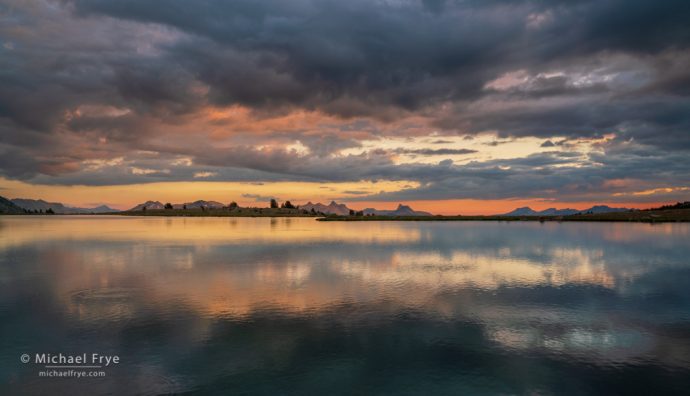
Cathedral Range and reflections at sunset, Yosemite. We huddled under trees for about an hour, waiting out a rainstorm, and were rewarded with this beautiful sunset.
Every summer we get periods of monsoonal moisture pushing up into California from the south, producing afternoon showers and thunderstorms. One of those periods coincided with our recent workshop in the Yosemite high country, and we got to photograph some beautiful sunrises and sunsets.
On the second afternoon of our workshop we hiked over a ridge to an alpine lake basin. There were some thunderstorms in the area, but none were very close when we started our hike, so I thought we might stay dry – and we had rain gear just in case.
(more…)
by Michael Frye | Jul 22, 2018 | Light and Weather
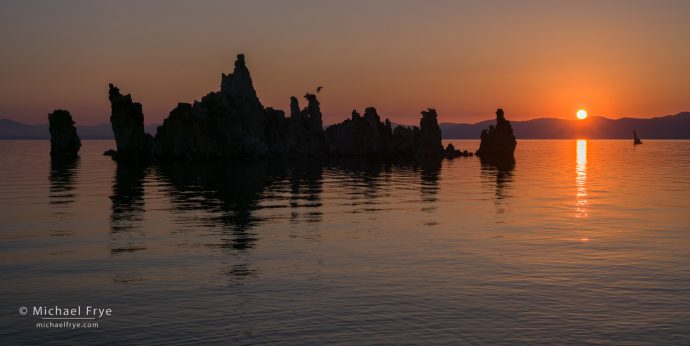
Osprey bringing a fish back to its nest at sunrise, Mono Lake. A thin band of smoke hung on the horizon to the east, turning the sun into a nice orange ball as it crested the horizon. We had watched an osprey bring a fish back to its nest on the tufa towers on a previous morning, so this time I was anticipating it. As the sun rose I heard the adult at the nest calling, so I got ready, setting my shutter speed to 1/350th of a second to freeze motion (at f/8 and ISO 100). The other adult flew in low and fast from the right, then rose up to the nest as I held down the shutter button. The bird is just a small accent at this size, but would be clearly visible in a big print.
Unusual conditions can provide interesting opportunities for photographs. Any unusual conditions – even things we don’t normally think of as photogenic. Photographers typically avoid smoke, for example, but smoke can create some wonderful atmospheric effects.
The Ferguson Fire started on the second day of our recent workshop in the Yosemite high country, but we didn’t see any smoke at first. Then on our fourth afternoon (Sunday the 15th) smoke started pouring over the mountains from the west. Instead of bemoaning our luck, we just went with it, sought out subjects that might work with the conditions, and ended up finding some interesting stuff, especially around sunrise and sunset.
(more…)

















